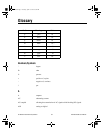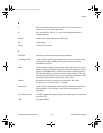
Glossary
©
National Instruments Corporation G-9 PCI-4451/4452 User Manual
H
h hour
half-power bandwidth the frequency range over which a circuit maintains a level of at least –3 dB
with respect to the nominal level
handshaked digital I/O a type of digital acquisition/generation where a device or module accepts
or transfers data after a digital pulse has been received. Also called latched
digital I/O.
hardware the physical components of a computer system, such as the circuit boards,
plug-in boards, chassis, enclosures, peripherals, and cables
hardware triggering a form of triggering where you set the start time of an acquisition and gather
data at a known position in time relative to a trigger signal
Hz hertz—cycles per second. Specifically refers to the repetition frequency of
a waveform.
I
IC integrated circuit
IMD intermodulation distortion—the ratio, in dB, of the total rms signal level of
harmonic sum and difference distortion products, to the overall rms signal
level. The test signal is two sine waves added together according to the
following standards:
SMPTE—A 60 Hz sine wave and a 7 kHz sine wave added in a
4:1 amplitude ratio.
DIN—A 250 Hz sine wave and an 8 kHz sine wave added in a
4:1 amplitude ratio.
CCIF—A 14 kHz sine wave and a 15 kHz sine wave added in a
1:1 amplitude ratio.
in. inches
INL integral nonlinearity—a measure in LSB of the worst-case deviation from
the ideal A/D or D/A transfer characteristic of the analog I/O circuitry
input bias current the current that flows into the inputs of a circuit
User.book Page 9 Tuesday, April 14, 1998 10:20 AM


















